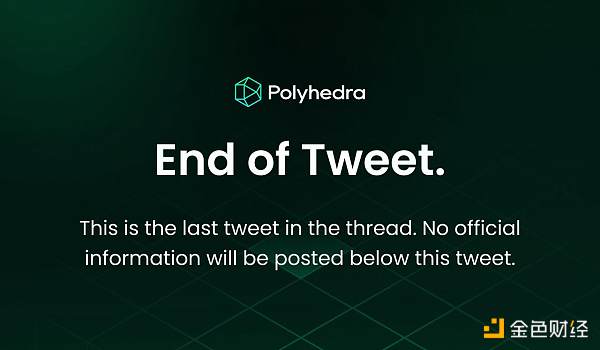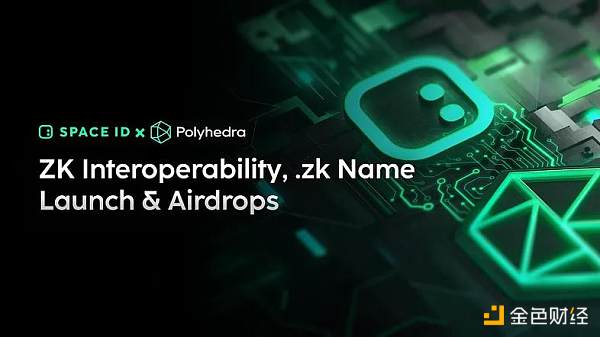Author: DeMan; Source: PANews
Online OKX Jumpstart, taking advantage of the Cancun upgrade to benefit: Why did Polyhedra plummet in the short term?
Polyhedra Network announced the launch of ZK technology OKX Jumpstart through social platforms on March 12, and completed a key snapshot at 16:00 on the same day . This snapshot not only concerns zkBridge trading users, Pandra King NFT holders, and zkBridge loyalty points users on Galxe, but also covers users who participated in the Binance Web3 Wallet Airdrop, OKX Cryptopedia Season 11, and BNB Chain Airdrop Marathon, bringing them Here comes the qualification for ZK airdrop.
On the same day, OKX Jumpstart announced a new project to support ZK (Polyhedra Network), starting at 6:00 am UTC time on March 15 , users can obtain ZK tokens by staking BTC and ETH. However, as these news came out, Pandra King NFT experienced violent price fluctuations in just three hours. It was first smashed, then pulled, and then smashed again. The floor price fell from 0.78 BNB to 0.26 BNB, a drop of Nearly 67%.
The market has different interpretations of this fluctuation. Some people speculate that it is because some people learned the news in advance and sold it first, with 0.6 BNB NFT is sold in the price range of -0.8 BNB. However, as the snapshot time approached, heavy buying pushed the price of Pandra King above 0.6 BNB, even reaching a peak of 0.8 BNB three minutes before the snapshot. After the snapshot, the price fell rapidly, with the floor price falling to 0.15 BNB within 10 minutes, almost halved.
Behind the chaos, let’s take a deeper look at the story of the Polyhedra Network project itself.
From the perspective of technical logic, how does zkBridge achieve cost reduction and efficiency improvement of Polyhedra Network?
Polyhedra Network introduces zkBridge and adopts zero-knowledge proof (ZKP) technology, marking a challenge to the existing cross-chain interaction performance and security A major breakthrough. In the key area of blockchain interoperability, zkBridge is not only an important contribution of Polyhedra Network to the construction of Web3 infrastructure, but also demonstrates a new direction for cross-chain technology.

The following is a detailed analysis of its main technical features:
1. Core technology application: zkBridge uses zk-SNARKs (zero-knowledge succinct non-interactive knowledge proof), an advanced encryption technology, to achieve the security of cross-chain data verification sex and efficiency. This technology enables the verifier to confirm the authenticity of an operation or transaction without revealing any actual information.
2. System composition: The core components include the block header relay network and the updater contract. The former is responsible for capturing block header data from the source chain and generating corresponding validity certificates. This process ensures the authenticity and integrity of the data and provides a reliable data source for cross-chain interactions; the latter is deployed on the target chain to receive and verify the block header and validity certificate from the source chain. After successful verification, the updater contract updates its internal state to reflect the latest state changes of the source chain.

3. Optimize the verification process: zkBridge optimizes the cross-chain verification through zk-SNARKs technology performance, greatly reducing computational complexity and resource consumption. This not only improves the efficiency of cross-chain interactions, but also reduces operating costs.
4. Concise data transmission: Another advantage of zk-SNARKs is that the generated proof is extremely concise, which means that it can be transmitted between chains The amount of data required is significantly reduced. This feature is crucial to increase the speed of cross-chain communication and reduce bandwidth consumption.
5. Extensive interoperability: zkBridge is designed to support a variety of cross-chain operations including asset transfers, smart contract calls, etc., greatly expanding Application possibilities within the Web3 ecosystem. By providing a secure and efficient cross-chain infrastructure, Polyhedra Network paves the way for seamless interaction between different blockchains.
In summary, Polyhedra Network’s zkBridge not only provides cross-chain interoperability in terms of security and efficiency by introducing zk-SNARKs technology It provides innovative solutions and lays a solid foundation for building an open and interconnected blockchain ecosystem.
On the occasion of the Ethereum Cancun upgrade, Polyhedra upgraded zkBridge technology to achieve asset interoperability between Bitcoin and Ethereum
< p dir="ltr" style="text-align: left;">With the rapid expansion of the Bitcoin ecosystem, especially since the launch of the Ordinals protocol, there is an urgent need for a method that can achieve seamless operation within Bitcoin and its second-layer network. solutions that seamlessly interact with each other while promoting its interoperability with other blockchain ecosystems such as Ethereum. Polyhedra Network applies its original zkBridge technology and is committed to building the broadest interoperable Bitcoin ecosystem, aiming to expand the potential of Bitcoin to enable it to interoperate with multiple first- and second-layer blocks, including Ethereum. Chain network interacts seamlessly.
The introduction of zkBridge technology is Polyhedra Network's key measure to promote the further development of the Bitcoin ecosystem. This interoperability protocol provides a trustless and efficient cross-chain communication solution through zero-knowledge proof (ZKP) technology. zkBridge enables Bitcoin to not only achieve seamless interoperability within its own ecosystem, but also enable efficient data and asset exchange with external blockchain networks.
zkBridge's Bitcoin messaging protocol extends Bitcoin's capabilities to securely transfer Bitcoin's current and historical data through zero-knowledge proofs Transfer to over 20 different networks, including Bitcoin’s layer 2 network, Ethereum and its layer 2 extensions. This innovation is not only compatible with the latest Bitcoin innovations such as Ordinals, BRC-20 and Atomics, but also enables smart contracts on other blockchain networks to access Bitcoin data and protocols without trust and execute various computational logic.
In order to solve the limitation of Bitcoin's lack of smart contract capabilities, Polyhedra Network adopts a proof-of-stake mechanism that allows validators to obtain from the sending chain Tokens and write data on Bitcoin to ensure the security of cross-chain transactions. Through cooperation with EigenLayer and Babylon, etc., a carefully designed crypto-economic security reduction mechanism has been introduced to further enhance the security and efficiency of the solution.
Polyhedra Network partners with major builders of infrastructure, wallets, second-layer networks, DeFi protocols and tools within the Bitcoin ecosystem to launch The largest interoperable Bitcoin ecosystem powered by zkBridge. This move not only provides strong technical support for the builders of the Bitcoin ecosystem, but also provides a solid foundation for unleashing the full potential of Bitcoin and opens a new era of interoperability.
Polyhedra Network's zkBridge has implemented key technology updates in the face of Ethereum's upcoming Cancun-Deneb ("Dencun" for short) upgrade. To ensure continued compatibility and interoperability with the Ethereum ecosystem. The Dencun upgrade, by introducing Blob transactions, aims to improve data availability without increasing computing load, laying the foundation for Ethereum's future sharding technology. Specifically, zkBridge technology has made the following two updates.
The first is the block update circuit adjustment. The core changes brought about by the Dencun upgrade include adding BlobKzgCommitments to BeaconBlockBody, and adding BlobGasUsed and ExcessBlobGas fields to ExecutionPayload. To adapt to these changes, zkBridge has made adjustments to its block update circuitry, which includes a comprehensive review and modification of the circuitry and related smart contract logic. Since changes in the block data structure directly affect the calculation formula of the block hash, zkBridge uses the data of the latest module version as circuit input to adapt to this upgrade.
The second is the Merkle Patricia Trie (MPT) proof generation upgrade. With the BlobTxType transaction type introduced in the Dencun upgrade, zkBridge must upgrade its dependent go-ethereum library to the latest version to support the new transaction format. This update ensures zkBridge is able to generate MPT proofs that are compatible with new transaction types.
These technical updates ensure that zkBridge can continue to provide efficient and secure cross-chain interaction services after the Ethereum Dencun upgrade. Adjustments to the block update circuit enable zkBridge to accurately reflect state changes in the Ethereum network, while upgrades generated by MPT proofs ensure zkBridge’s accuracy and reliability when processing new transaction types.
As Polyhedra Network completes the key snapshot on March 12, it is open to zkBridge trading users and Pandra King NFT holders, etc. The ZK airdrop activity of the user group marks its further expansion and opportunities in the Web3 field. Through this snapshot and the launch of the new project ZK in cooperation with OKX Jumpstart, providing users with the opportunity to use BTC and ETH to pledge in exchange for ZK tokens, Polyhedra Network has not only made adaptive adjustments to its financial model, but also heralded market supply and Positive changes in liquidity.
Challenges and risks are still severe, and the future of Polyhedra Network will not be smooth due to technological upgrades
To summarize, Polyhedra Network has made a key update to its zkBridge technology to adapt to the upcoming Ethereum Dencun network upgrade, which undoubtedly enhances its role as a cross-chain solution Competitiveness of the program. By adapting the block update circuitry and Merkle Patricia Trie proof generation, Polyhedra Network ensures seamless interoperability with the Ethereum ecosystem, further expanding its scope of applications in the decentralized finance (DeFi) space.
However, in the face of recent security attacks, Polyhedra Network quickly responded and emphasized that the incident had nothing to do with bridge security, demonstrating its commitment to technology. The ability to respond to challenges and commitment to the security of user assets. Although attacks resulting from key leaks pose technical and legal challenges, Polyhedra Network's transparent handling and quick response further solidifies its trust in the crypto community.

Token airdrops and partner cooperation events have also brought new liquidity to Polyhedra Network and market attention, but also tested its market stability and ability to absorb new liquidity.
To sum up, Polyhedra Network is in a critical development period, full of potential and facing challenges. Technology updates, continued expansion of the ecosystem and effective response to security attacks have jointly shaped its core position in the field of Web3 and cross-chain interoperability. In the future, how Polyhedra Network balances technological innovation and market demand and ensures the stability and security of the ecosystem will be the key to its success. For community members, this is both an opportunity to observe and evaluate, and a test of the Polyhedra Network’s continued investment and belief.
 JinseFinance
JinseFinance
 JinseFinance
JinseFinance JinseFinance
JinseFinance JinseFinance
JinseFinance Cheng Yuan
Cheng Yuan Sanya
Sanya decrypt
decrypt Numen Cyber Labs
Numen Cyber Labs Cointelegraph
Cointelegraph Cointelegraph
Cointelegraph Cointelegraph
Cointelegraph